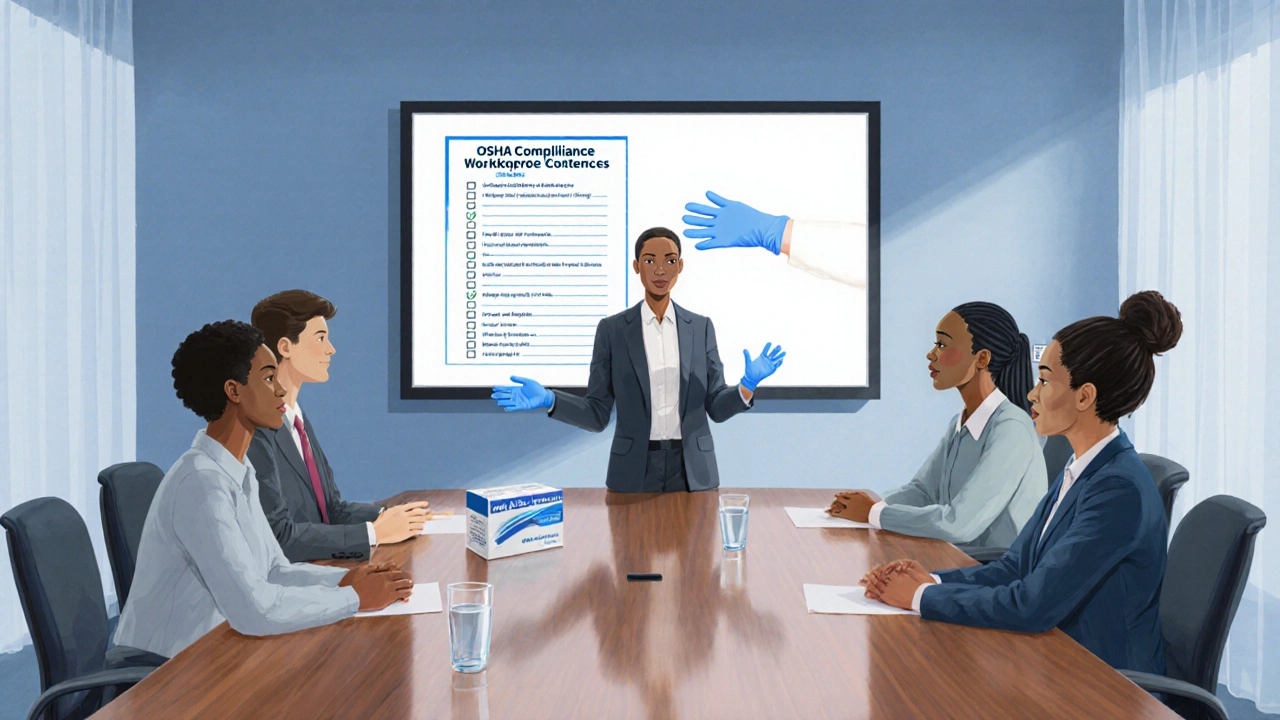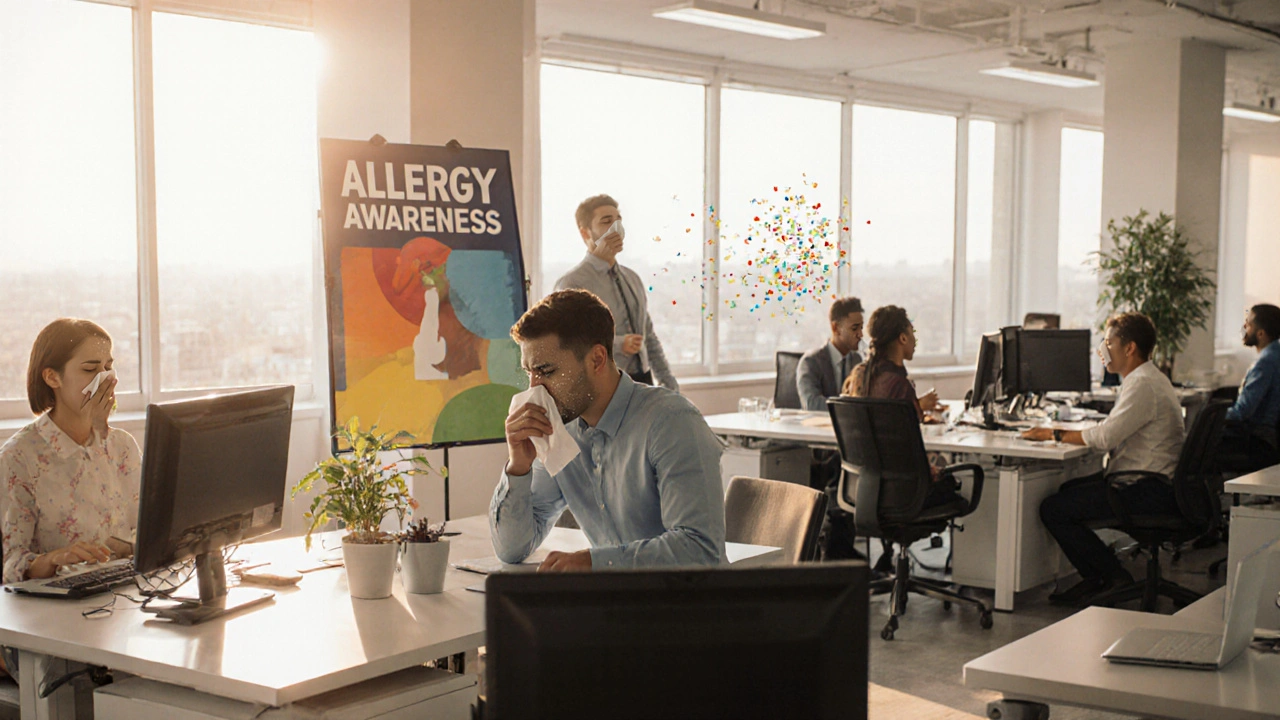Occupational Allergy is a type of allergy triggered by substances encountered in the workplace, ranging from chemicals to natural fibers. It affects up to 20% of employees in high‑risk industries, according to an Australian safety study published in 2023.
Quick Takeaways
- Identify common workplace allergens early through surveys and air sampling.
- Apply a hierarchy of controls: eliminate, substitute, engineer, administrate, then protect with PPE.
- Implement medical surveillance and an individualized return‑to‑work plan.
- Stay compliant with Safe Work Australia and OSHA guidelines.
- Use an action plan template to keep everyone on the same page.
Understanding Occupational Allergies
Allergic reactions in the workplace can manifest as respiratory issues, skin inflammation, or systemic symptoms. The most common forms include Workplace Asthma, a chronic condition where airway inflammation is provoked by inhaled allergens like dust, fumes, or chemicals, and Contact Dermatitis, a skin reaction caused by direct contact with irritants or allergens such as solvents, metals, or latex.
In Australia, the Australian Institute of Health and Welfare reported that occupational asthma accounted for 3,200 new cases in 2022, while contact dermatitis represented roughly 15% of all work‑related skin disorders.
Common Workplace Allergens
Knowing which substances are most likely to trigger reactions helps focus your prevention efforts. Below are the top culprits:
- Latex - found in gloves, catheters, and some flooring.
- Airborne Allergens - dust mites, pollen, mold spores, and animal dander that can infiltrate ventilation systems.
- Formaldehyde and other volatile organic compounds (VOCs) used in manufacturing.
- Chemical sensitizers like isocyanates in paint and foam production.
- Metallic powders such as nickel or chromium in machining.
Employers often overlook low‑level exposures, yet sensitization can develop after repeated, sub‑clinical contact.
Risk Assessment and Identification
A systematic risk assessment combines three steps: inventory, exposure measurement, and health surveillance.
- Inventory: List every material, process, and equipment that could release an allergen.
- Exposure Measurement: Use personal samplers, bulk sample analysis, or real‑time monitors to quantify airborne levels. The Engineering Controls are devices or modifications that reduce or eliminate exposure at the source (e.g., local exhaust ventilation).
- Health Surveillance: Conduct baseline skin prick tests, spirometry, and questionnaire surveys. Ongoing Medical Surveillance tracks employee health over time to spot early signs of sensitization.
Documenting findings in a risk register creates a living document that drives control decisions.
Prevention Strategies: The Hierarchy of Controls
The most effective way to keep allergens out of the work environment is to follow the hierarchy of controls. Each level builds on the one before it.
| Control Type | Effectiveness | Typical Cost | Implementation Time |
|---|---|---|---|
| Elimination / Substitution | High | Variable (often lower long‑term) | Weeks‑Months |
| Engineering Controls | Medium‑High | Moderate | Weeks |
| Administrative Controls | Medium | Low | Days‑Weeks |
| Personal Protective Equipment (PPE) | Low‑Medium | Low | Immediate |
Let’s walk through each level with practical examples.
1. Eliminate or Substitute
Where possible, replace latex gloves with nitrile alternatives. In a Sydney-based laboratory, swapping to nitrile cut allergic reactions by 87% within six months.
2. Engineering Controls
Install local exhaust ventilation (LEV) over sanding stations to capture silica dust. Add HEPA filters to HVAC systems to trap pollen and mold spores. These measures reduce airborne concentrations by up to 95% according to a 2022 Safe Work Australia case study.
3. Administrative Controls
Implement job rotation so that high‑exposure tasks are limited to 2‑hour blocks. Create a cleaning schedule that uses low‑allergen detergents. Provide training on proper handling of sensitizing chemicals.
4. Personal Protective Equipment (PPE)
When engineering controls are insufficient, equip workers with N95 respirators or disposable, hypoallergenic gloves. Remember, PPE is the last line of defense and requires fit‑testing and regular replacement.

Managing Employees Who Have Developed Allergies
Even with the best prevention plan, some workers will still develop symptoms. A compassionate, evidence‑based approach keeps them productive and reduces liability.
- Medical Evaluation: Referral to an occupational physician for diagnosis, spirometry, and allergy testing.
- Work‑Modification: Adjust duties to avoid the offending allergen; for example, move a latex‑sensitized employee to a non‑clinical role.
- Allergen Immunotherapy: In cases of perennial respiratory allergens, sub‑cutaneous immunotherapy can lower sensitivity (supported by a 2021 clinical trial in Melbourne).
- Return‑to‑Work Planning: Use a graded schedule, monitor symptoms, and involve the employee’s GP.
Document each step in the employee’s health record and maintain confidentiality per privacy regulations.
Legal and Regulatory Landscape
In Australia, the Safe Work Australia publishes model WHS Regulations and Codes of Practice that include allergen management guidance
Key obligations include:
- Identify hazards and assess risks (Section 19 of the WHS Act).
- Implement control measures as high up the hierarchy as reasonably practicable.
- Provide training and information to workers.
- Maintain health surveillance records for at‑risk occupations.
In the United States, OSHA’s Bloodborne Pathogens Standard and the General Industry Standard (1910) address some allergens, but many states have additional requirements. Aligning with both jurisdictions ensures a robust, globally‑compatible program.
Creating a Workplace Allergy Action Plan
Putting all the pieces together into a single, easy‑to‑follow document helps managers act quickly when an incident occurs.
- Assign an Allergy Safety Officer - usually an EHS specialist.
- List Identified Allergens - reference the risk register.
- Define Control Measures - note which level of hierarchy applies to each allergen.
- Outline Emergency Procedures - include first‑aid steps, who to call, and documentation flow.
- Set Review Frequency - at least annually, or after any incident.
Sample template (downloadable from most WHS resources) includes checkboxes for compliance verification.
Checklist for Ongoing Management
- Conduct annual allergen exposure surveys.
- Refresh PPE training every 12 months.
- Review ventilation filter efficiency quarterly.
- Update medical surveillance data after each health check.
- Audit the Allergy Action Plan after any new product introduction.
Following this routine keeps the program dynamic and prevents complacency.
Related Topics to Explore Next
If you found this guide useful, you might also want to read about:
- Industrial Hygiene Sampling Methods
- Psychosocial Impacts of Chronic Workplace Illness
- Designing Allergy‑Safe Office Spaces
- Legal Cases Involving Workplace Allergies
Each of these expands the conversation around creating a healthier, safer work environment.

Frequently Asked Questions
What is the difference between occupational asthma and general asthma?
Occupational asthma is triggered by substances encountered at work, such as dust or chemicals, and often improves when the worker is away from the exposure. General asthma can be triggered by a broader range of factors like pollen, exercise, or cold air, and isn’t tied to a specific workplace.
How often should a workplace conduct allergen risk assessments?
A formal assessment should be done at least once a year, and whenever a new material, process, or equipment is introduced that could change exposure levels.
Can PPE alone protect workers from allergens?
PPE is the last line of defense. It works best when combined with higher‑level controls like elimination, substitution, or engineering solutions. Relying solely on PPE leaves gaps if equipment is misused or fails.
What legal obligations do Australian employers have for allergy management?
Employers must follow the Work Health and Safety Act, identify and control hazards, provide training, and keep health surveillance records for at‑risk workers. Safe Work Australia’s codes of practice give detailed steps for managing allergens.
Is allergen immunotherapy effective for workplace‑related allergies?
Clinical trials in Australia and Europe show that sub‑cutaneous immunotherapy can reduce symptom severity by 40‑60% for perennial allergens like dust mites and molds, making it a viable option for chronic occupational cases.


Post A Comment